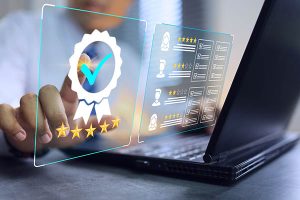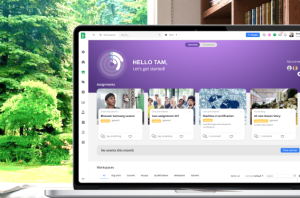An enterprise-sized organization has needs that can’t be met by a “one size fits all” Learning Management System (LMS). This article explores which key features of enterprise learning management systems are required for to help large organization grow.
An enterprise-sized organization has needs that can’t be met by a “one size fits all” Learning Management System (LMS). These companies are defined by their rapid rate of growth. With a regular influx of new starters, large-scale organizations need enterprise learning management procedures in place that are reliable to ensure their rate of growth doesn’t hinder their business operations. This article explores which key features of enterprise learning management systems are required for to help large organization grow.
What is enterprise learning management?
Enterprise learning management relates to the policies, procedures, and overall management of all the learning and training that takes place across the organization. It involves the creation of learning materials, allocating modules to different job roles, monitoring team progress, and more.
What about standard learning management systems?
A standard LMS often can’t keep up with the rate of growth experienced by an enterprise. You need to deliver outstanding service to everyone who uses the system, and that can’t always be guaranteed with a typical LMS. This is particularly true if you require customizations.
The features of enterprise learning management systems
Let’s take a look at what features of an enterprise learning management system would be beneficial to enterprise-sized organizations.
1. Customizable platforms for complex hierarchies and training workflows
Every business is different which is why a standardized product won’t work well for enterprises. Training needs to be assigned to specific job roles but this gets confusing when people work complex work schedules. Some people may work in multiple roles; a hybrid mix of job responsibilities. A traditional LMS struggles to automate the correct allocation of training.
Also, for highly regulated industries, keeping workers continuously up-to-date and qualified to meet regulatory compliance can require very complex training processes and structures, which many standard LMS do not have the depth of capability or sophistication to provide.
It is important to find an LMS which is flexible and adaptable, or even built in a modular way that makes it easily customizable to fit and flex to the needs of enterprise-sized companies. It makes them scalable to meet your current needs and your future needs as your company grows.
2. In-depth insight with real-time and historic data analytics drives efficient management
An enterprise-sized organization has a huge amount of people. It becomes difficult to put a name to a face. How do you gauge who’s doing well, and who needs additional support? Your Management team requires accurate data at their fingertips, securely stored. With this data, they can make empowered decisions to ensure they achieve great ROI from their enterprise learning management procedures and policies.
An ideal enterprise learning management system tracks everyone’s progress so you can access this in real-time and view historical data at the touch of a button. This enables you to identify challenges and receive automated reports. With this valuable information, you can pinpoint the best option for the decisions you need to make.
You have complete insight into how people are progressing in the tasks you set. This panoramic view of insights allows you to monitor whether you’re on track to meet your quarterly and annual targets. These insights are customizable so you can drill down into exactly what drives performance.
3. Easy deployment
Deployment and integration are often critical and challenging times for the launch of an enterprise sized learning management system. A clumsy deployment project can impact many departments and could even result in low adoption levels and a failed platform launch. It’s really important to ensure that you gain hands-on help and guidance during the implementation phase. User friendly APIs can also speed the product’s integration, making your launch simpler. Using a seasoned learning management provider to provide wraparound consultancy that supports your learning strategy and training processes is also very valuable. This ensures that the objectives of your long-term training vision are captured and delivered.
4. Proactive support
Technical difficulties have a huge impact on your entire organization’s progress. What if something stops your entire organization from logging in or accessing learning? If the LMS you use has only experienced supporting small and medium-sized companies, they may not have the in-house resources to quickly solve this problem on such a huge scale. This could result in unnecessary downtime that slows down your progress and costs your organization money.
5. Expense management
Enterprise learning management systems require more than tracking training and generating certificates. You want a tool that combines essential features so these can all be accessed from one console. Being able to manage all training-related expenses, and resources, track your budget and drive your ROI is invaluable.
6. Unlimited cloud-based storage for remote access
Enterprise-sized companies have huge amounts of information needing to be securely stored away, ready for instant access from any device. There’s also highly confidential personal information used in an LMS. This includes an employee’s address, date of birth, progress scores, and even payment information.
An enterprise LMS should use cloud technology to deliver a flexible approach. Anyone should be able to pick up their smartphone and continue their learning from anywhere with an internet connection. A large and accessible knowledge center, further boosts ease of use enabling a rapidly growing team to self-serve the information they need.
7. User-friendly for all employees to drive user adoption
Your ROI is massively affected if you invest in an LMS that’s clunky and complex for the people using it every day. If it’s taking ages for your team to log in with a complex User Interface, it will take much longer for learning targets to be met. This impacts productivity levels and training completion rates. Being difficult to use will drastically affect your enterprise LMS adoption rates. Ultimately, if your platform is annoying and cumbersome, your enterprise LMS deployment could be a failure resulting in a significant amount of wasted training budget and time.
A user-friendly enterprise LMS functions as both a productive workspace and a career-boosting tool. Giving each user their own portal where they can view upcoming training, read the latest company news, and share posts increases their engagement in the platform and therefore boosts your platform adoption levels. Training should be accessible on the go from a cloud-based knowledge center. Having all their professional accomplishments stored in one place gives them visibility into what they need to do to reach the next stage in their career.
8. Working collaboratively across departments
Effective training programs sit across many different departments and need direct cooperation from most of the business’s leaders to be delivered successfully. Working cross-departmentally can be challenging, especially if different departments have different skills, shift patterns and processes. Having one, united communication platform to drive training and performance is priceless within an enterprise-sized organization. It helps avoid silos and a fragmented approach and helps you drive productivity.
9. Works for your industry
Every sector has different pain points and different competition levels. One standard LMS may provide a high standard of efficiency for secondary schools, but when a call center uses it, they can’t utilize all the features.
A fully customizable enterprise learning management system, should be tailored to meet the needs of many different industries. No matter what industry you work in, you can tighten your management with resource control and qualification processes.
10. Automated compliance
Compliance is an essential part of every organization. Enterprise learning management is a great way of following business regulations and ensuring your team is following each procedure to the certified standard.
High performing enterprise learning software helps you to actively manage your compliance status:
- Create quizzes for your compliance regulations
- Access data to see your current compliance performance levels
- Identify people not following your defined procedures
- Provide documented evidence that ensures you’re ready to undergo a compliance audit
- Automate the process of creating certifications and receive notifications when a certification is going to expire in plenty of time
11. Effective training on a mass scale
What categorizes the size of an organization as an enterprise is the rate of growth. Enterprises have a continuous flow of new starters in need of training to become outstanding members of the team. They need their learning tasks allocated for them to begin. But with so many people within one enterprise, how do you know if the training is actually working for them?
Your enterprise learning management system should provide many opportunities for quantifiable feedback so managers can see if their training content is effective or if it needs to be reviewed and started again. From one place, you should be able to manage all your training resources, cut down on your training expenses, and tap into exam results.
12. Create an immersive, interactive learning experience to boost learner engagement
Indeed’s career guide describes the purpose of training: “It represents a good opportunity for employees to grow their knowledge base and improve their job skills to become more effective in the workplace.”
People learn in different ways. The 4 types of learners are known as:
- Visual learners
- Auditory learners
- Kinesthetic learners
- Reading/writing learners
Providing document after document and expecting everyone to learn in that way is unrealistic. You need a way to include various types of learning material to keep users engaged and enthusiastic.
The best enterprise learning packages enable you to mix up your courses with customizable templates. They offer a wide variety of ways to present content, such as uploading images, text, links to audio and video content. Breaking up information with assessments, quizzes, surveys, and certificates boosts engagement levels and course completion rates.
Blossom’s enterprise learning management platform is a powerful tool that drives your business
Ultimately, Blossom is a powerful enterprise learning management tool that enables your team to upskill quickly and stay organized, which drives your business as a whole. Blossom delivers all the features and functions mentioned in this article and much more. Meet your company-wide goals by empowering your team with our easy-to-use tool.
Blossom provides extensive support to all of our customers, even those with challenging connectivity and offline conditions. Our expert technical team are ready to listen to your queries and provide solutions to them. As established providers to international telecoms companies, the Israeli Ministry of Justice and El-Al Airlines, Blossom’s technical team has the scale and resilience to keep enterprise-sized companies running smoothly.
When dealing with high levels of growth, you require robust enterprise learning management that can keep up with your rate of onboarding. With Blossom, you can tap into metrics from one console to ensure you’re on track to meet targets and clearly identify who needs more support. Book a demo with Blossom to see how its advanced enterprise learning management platform functions can drive your business.
Blossom’s blog contains more tips and information from the digital world for complete organisational management.








